Adult ID Guide
Knowing how to identify adult coho salmon, steelhead, and Chinook is a critical skill for anyone fishing waters where these species coexist. In some areas, such as the Russian River, coho and other salmon species are protected, and catching or harming one can lead to penalties and stiff fines. This guide, developed by the California Sea Grant Russian River Salmon and Steelhead Monitoring Program, can help you refine your salmon ID skills. For current fishing rules and regulations please visit the California Department of Fish and Wildlife website and call the Low-Flow Closure Hotline at 707-944-5533 before heading out on the water.
If you are not completely confident in the identification of a fish, handle it with great care and release immendiately.
The following features can help you distinguish between these similar-looking fish:
| Coho | Chinook | Steelhead | |
|---|---|---|---|
| Body | Deeper bodied than steelhead | Larger and deeper bodied than both coho and steelhead | More streamlined (longer and skinnier) than coho or Chinook |
| Nose | Upper hook-nose (kype) usually present on mature male | Upper kype, not as bulbous as coho | If any kype present, it will be lower jaw |
| Mouth | Dark mouth with white gums | Dark mouth with dark or black gums | All white mouth |
| Tail | Spots on upper lobe only | Spots on both lobes | Spots on both lobes, often aligned in straight lines |
| Color | Larger and fewer spots. Green heads and maroon flanks when mature | Mature fish are usually brownish-green with large peanut or 'W' spots | Pink cheeks and flanks, smaller spots on body and tail |
*Please note there is a lot of variation between individuals, and not every fish will display all of these characteristics exactly.
Steelhead Trout
Steelhead and rainbow trout are the same species (Oncorhynchus mykiss). Steelhead migrate to the ocean while rainbow trout stay in streams. Steelhead have a longer, skinnier body shape than coho and Chinook salmon, usually no hook nose on males, pink cheek and flanks on mature males, small numerous spots on body and tail. The most definitive characteristic for identification is the pure white mouth.
Colored (sexually mature) male Steelhead Trout (photo credit: California Sea Grant)
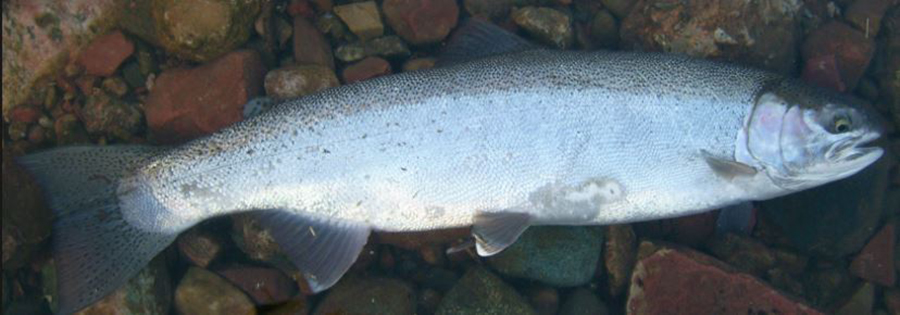
Female Steelhead Trout (photo credit: Creative Commons)
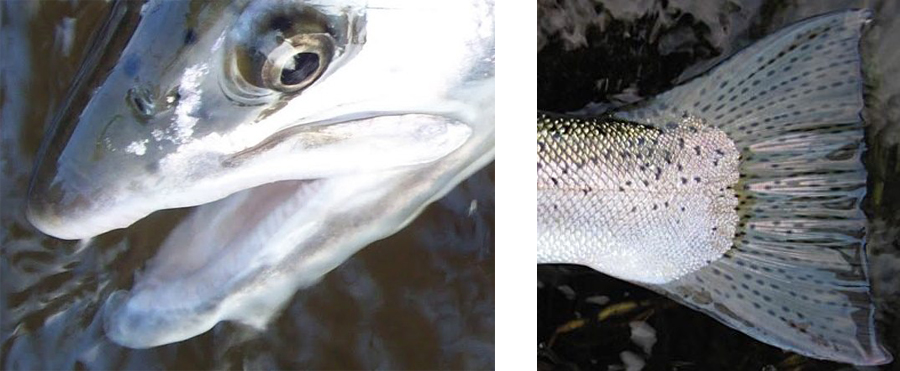
Steelhead have a completely white mouth (left) and a square tail with a thick peduncle (right). (photo credit: California Sea Grant)
Coho salmon
Coho are deeper bodied than steelhead, spots are larger and less numerous than on steelhead. Males often have a hook nose. Coloration of mature fish often includes red (maroon) flanks and a green head. Note the white gum line against a black mouth, this will be the most definitive characteristic for identification. The nares (nostrils) will also be highlighted with white.
Coho male (photo credit: Washington Department of Fish and Wildlife)
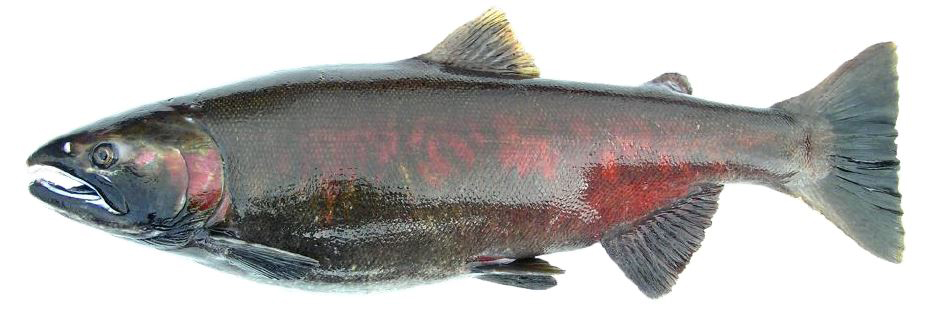
Coho female (photo credit: Washington Department of Fish and Wildlife)
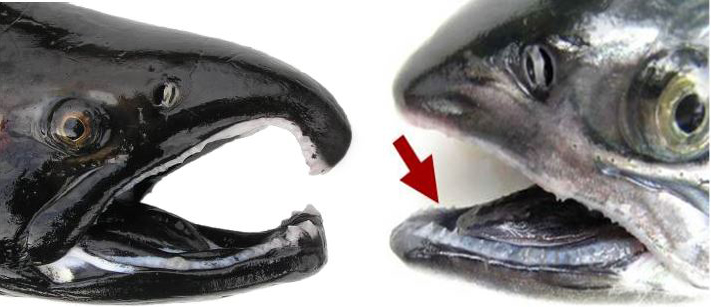
Coho usually have a dark mouth with white gum-line, upper hook-nose usually present when males (left) mature. (photo credit: Washington Department of Fish and Wildlife)
Male coho. Note the large bulbous nose, white gum line, white nares and only spotting on the upper lobe of tail. (photo credit: California Sea Grant)
Coho jack (two-year old salmon). Note the white nare and white gum line. (photo credit: California Sea Grant)
Spawned male coho carcass. Note the white nares, and dark mouth with white gum line. (Photo Credit: California Sea Grant)
Coho male shortly after entering freshwater. Note white gum line and white nares. (photo credit: California Sea Grant)
Chinook salmon
Chinook are larger and deeper bodied than coho and steelhead. They have a dark mouth with black or dark colored gums. They often have “peanut” shaped spots that are larger than spots on coho and steelhead, mature fish are usually brownish green, although males can be pure (body and head) red during spawning window.
Chinook male (photo credit: Washington Department of Fish and Wildlife)
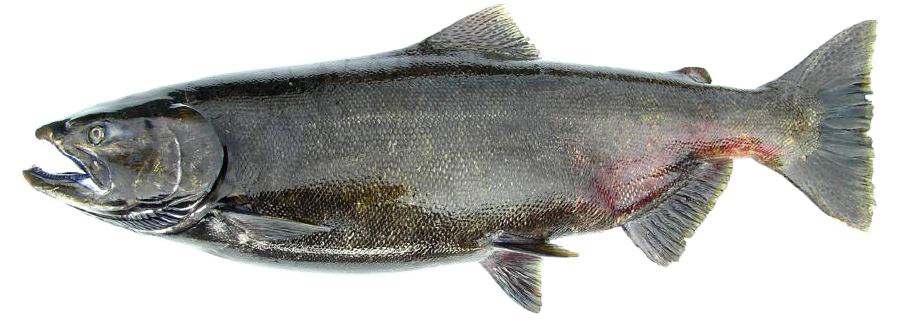
Chinook female (photo credit: Washington Department of Fish and Wildlife)
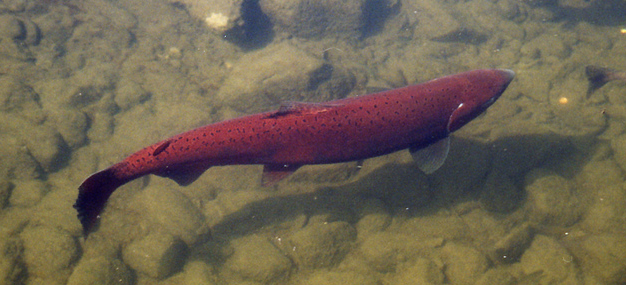
Male Chinook: Note the entire body is red including the head. (photo credit: Diana K/Creative Commons)
Note the all black mouth and gumline on this Chinook. (photo credit: Washington Department of Fish and Wildlife)
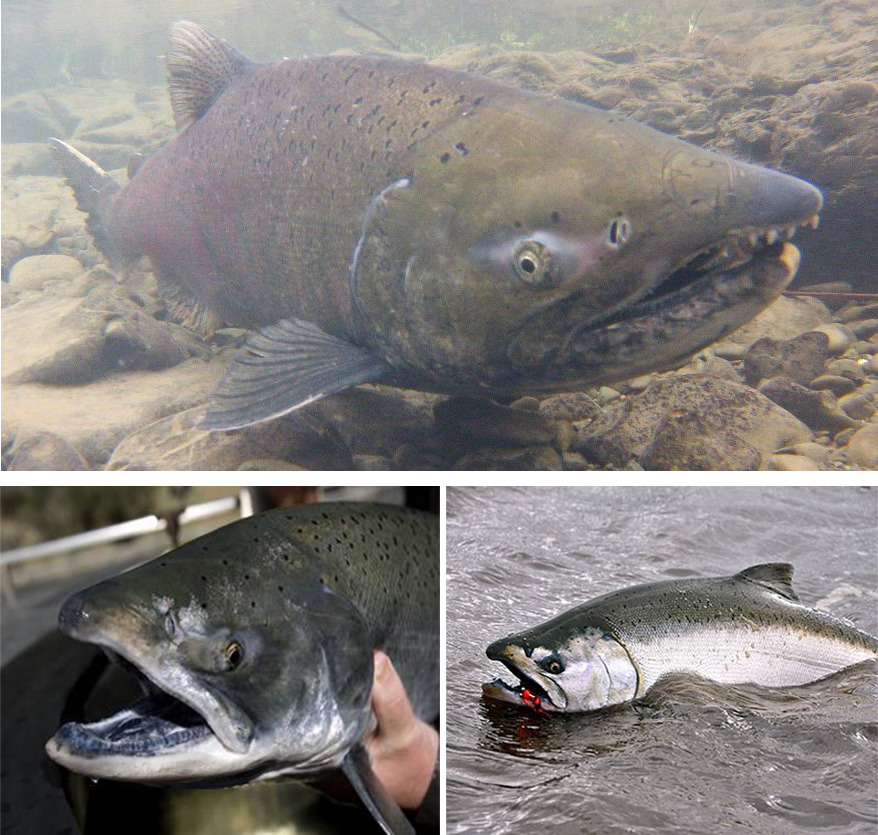
Chinook salmon (top: William Boucher) (bottom left: Kimberly White/Getty Images) (bottom right: Rob Russell)
Now TEST YOUR ADULT SALMONID ID SKILLS!
Know your salmon species to avoid catching endangered coho
Coho salmon and steelhead primarily spawn in tributaries, smaller creeks that flow into the river, rather than the mainstem of the Russian River. During low rainfall years and early in the season, it is more important than ever to be conscious of the impact of angling on these protected fish. Check out our Angler Resources for more information on ID'ing and safe handling of Russian River salmonids.
Juvenile ID
View the juvenile guide below:
References and Recommended Readings
- Fishes of California, California Department of Fish and Wildlife
- Groot, C., & Margolis, L. (1991). Pacific salmon life histories. Vancouver: UBC Press.
- McGinnis, S. M., & Alcorn, D. (2006). Field Guide to Freshwater Fishes of California.
- The Behavior and Ecology of Pacific Salmon and Trout
- NOAA Fisheries Species Directory
- California Fish






